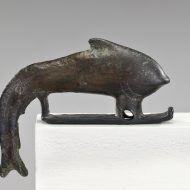Hatmehit : The Nile Goddess
Listen
At a glance
| Description | |
|---|---|
| Origin | Egyptian Mythology |
| Classification | Gods |
| Family Members | Banebdjedet (Husband) |
| Region | Egypt |
| Associated With | Nile, Agriculture |
Hatmehit
Introduction
The goddess Foremost of the Fish was a deity in the 16th Lower Egyptian nome. She was worshipped in the Delta under Mendes. Her cult was heavily influenced by the ram known as Banebdjedet, who was also known as the consort of Mendes. During the Late Period, Foremost of the Fish was involved in the search for the remains of Osiris.
Hatmehit is an ancient Egyptian goddess of fish and the inundation of the Nile river. She was personified with Hatmehit, the sixteenth nome of Lower Egypt and associated with the nome’s provincial capital city, Mendes. She may have originally been the city’s main deity, before being overshadowed by Banebdjedet, who is often considered to be her husband.
Physical Traits
She has been depicted as either a fish or as a woman with a crown or an emblem on her head, similar to the nome symbol found in Lower Egypt. Because of this, it can be hard to distinguish images of Hatmehit from those of a female deity based on Mendesian nome depictions.
It has been debated whether or not the fish that is associated with Hatmehit is a dolphin, a schilbe, or a lepidotes. However, the iconography of this deity is consistent with that of a fish. Most recently, the work of Susan and Donald Redford focused on the idea that the fish was a schilbemystus.During the later periods, Hatmehit adopted the iconography of Hathor and Isis. Her fish standard was replaced by the sun disk and horns.
Family
She was a part of the Mendesian triad, which included Harpocrates and the god Banebdjedet. Her cult was restricted to Nome 16 in Lower Egypt, but depictions of her can be found in various locations, such as the temples of Dendera, Edfu, and Bebeit El Hagar. The earliest known proof of Hatmehit can be found in the Old Kingdom, as she was depicted on the walls of Sahure’s mortuary complex.
Other names
Hatmehit’s name is typically translated as “Foremost of Fish”, literally from the words ḥꜢt “Chief, head, foremost” and mḥyt “fish” (as a mass noun). However, the word mḥyt in Hatmehit’s name does not include the fish determinative, which allows it to have a double meaning.
Powers and Abilities
The similarities between the nome and Hatmehit’s iconography suggest that she was the titular deity of Mendes, and her spheres of influence were linked to the lifestyle and concerns of its residents. For instance, due to the city’s role as a perfume production center, Hatmehit was associated with good scents.
Modern Day Influence
Sited near an ancient harbor, the shrine to Hatmehit has been the only one found so far in Mendes. Other objects such as fish-shaped jars and beer jugs have also been discovered in the area. These represent the offerings made to the goddess. The worship of the goddess faded away by the arrival of the Last Dynasty and is considered to be a minor deity in todays standards.
Related Images
Frequently Asked Questions
What is lorem Ipsum?
I am text block. Click edit button to change this text. Lorem ipsum dolor sit amet, consectetur adipiscing elit. Ut elit tellus, luctus nec ullamcorper mattis, pulvinar dapibus leo.
What is lorem Ipsum?
I am text block. Click edit button to change this text. Lorem ipsum dolor sit amet, consectetur adipiscing elit. Ut elit tellus, luctus nec ullamcorper mattis, pulvinar dapibus leo.
What is lorem Ipsum?
I am text block. Click edit button to change this text. Lorem ipsum dolor sit amet, consectetur adipiscing elit. Ut elit tellus, luctus nec ullamcorper mattis, pulvinar dapibus leo.
What is lorem Ipsum?
I am text block. Click edit button to change this text. Lorem ipsum dolor sit amet, consectetur adipiscing elit. Ut elit tellus, luctus nec ullamcorper mattis, pulvinar dapibus leo.
What is lorem Ipsum?
I am text block. Click edit button to change this text. Lorem ipsum dolor sit amet, consectetur adipiscing elit. Ut elit tellus, luctus nec ullamcorper mattis, pulvinar dapibus leo.













